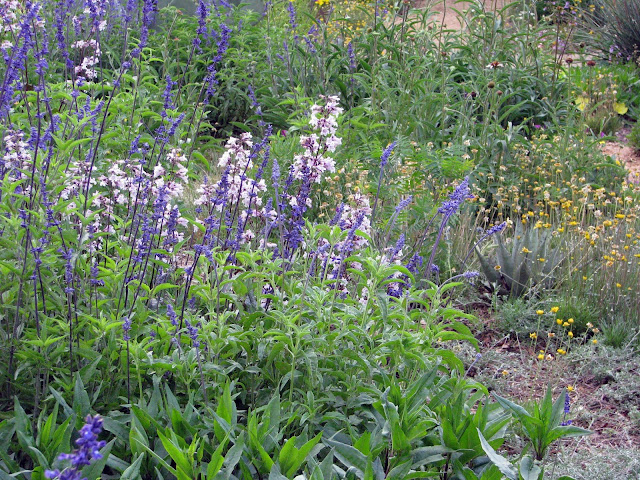First, a public service announcement about a free garden tour:
Dallas County Master Gardeners will be conducting free 30-minute talks on Water-Wise gardening every hour on the hour at each of the tour headquarters. Dallas County Master Gardener volunteers will also be assisting homeowners and helping answer questions about the plants and landscapes on the tour.
Click here for additional information, as well as photos, videos, and plant lists for the gardens on tour.
Click here for additional information, as well as photos, videos, and plant lists for the gardens on tour.
Maps for the self-driving tour are available at SaveDallasWater.com and at all tour headquarters.
Second, even though my garden is not on the tour, I have been happy to give impromptu personal tours to neighbors, interested strangers that drive by, readers of the blog, and a garden blogger in town from San Antonio.
Shirley Fox, famous for the Rock-Oak-Deer blog, was in town recently and stopped by for a tour of the garden.
This was Shirley's second visit. When she and her husband stopped by last year, the plants in the garden were about a month ahead of their normal growth because of the warm winter. This year, Shirley had the opportunity to see the plants on a normal growth schedule and to also see my latest finished and unfinished projects. Click on the Rock-Oak-Deer link above for a look at my garden through Shirley's camera.
Third, this past weekend while the Big Yellow Caterpillar was parked in front of my house and the portable toilet was in the street in front of my neighbors house, I created a moving, three minute tour of my garden. Moving, as in video. Not moving as in emotional, unless jerky, fast moving video makes you nauseous, then you may be moved.
Shirley Fox, famous for the Rock-Oak-Deer blog, was in town recently and stopped by for a tour of the garden.
This was Shirley's second visit. When she and her husband stopped by last year, the plants in the garden were about a month ahead of their normal growth because of the warm winter. This year, Shirley had the opportunity to see the plants on a normal growth schedule and to also see my latest finished and unfinished projects. Click on the Rock-Oak-Deer link above for a look at my garden through Shirley's camera.
Third, this past weekend while the Big Yellow Caterpillar was parked in front of my house and the portable toilet was in the street in front of my neighbors house, I created a moving, three minute tour of my garden. Moving, as in video. Not moving as in emotional, unless jerky, fast moving video makes you nauseous, then you may be moved.
This was my first time to create and edit a video and it shows. But it was fun and I will probably do this again. Maybe I will add narration next time. And maybe I will even get on YouTube so I can post longer videos. Flickr limits my creativity by only allowing me to post three minute videos.

Finally, this is a photo of Mexican Hat, Ratibida columnaris, that was supposed to be part of my last post's photographic tour of the garden. Oops.

Finally, this is a photo of Mexican Hat, Ratibida columnaris, that was supposed to be part of my last post's photographic tour of the garden. Oops.







































